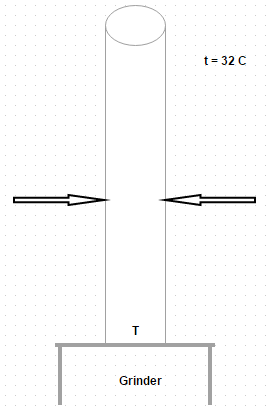This set of Heat Transfer test focuses on “Fin Performance”.
1. The utility of fin in dissipating a given quantity of heat is generally assessed on the basic of how many parameters?
a) 1
b) 2
c) 3
d) 4
View Answer
Explanation: It depends on two parameters i.e. efficiency of fin and effectiveness of fin.
2. A copper steel rod (k = 55 W/m degree) has been attached to a plane wall which is maintained at a temperature of 350 degree Celsius. The rod is 8 cm long and has the cross-section of an equilateral triangle with each side 5 mm. Determine the heat dissipation from the rod if it is exposed to a convection environment at 25 degree Celsius with unit surface conductance 100 W/m2 degree. Consider end surface loss to be negligible
a) 10.26 W
b) 9.26 W
c) 8.26 W
d) 7.26 W
View Answer
Explanation: For a fin of triangular cross-section, P = 3a and m = (h P/k A) ½ = 50.19 per meter.
3. For an infinitely long fin, the efficiency of fin is given by
a) 1/ml
b) 2/ml
c) 3/ml
d) 4/ml
View Answer
Explanation: On simplify (p h k A C) 1/2 (t 0 – ta) tan h (ml)/h (p l) (t 0 – ta), we get it as tan h (ml)/ml. And here for very long fin numerator should be equal to 1.
4. For a fin of finite length with an insulated end, the fin efficiency is given as
a) tan h (ml)
b) tan (ml)/ml
c) tan h (m)/ml
d) tan h (ml)/ml
View Answer
Explanation: On simplify (h p k A C) 1/2 (t 1 – t 2) tan h (ml)/h (p l) (t 1 – t2), we get it as tan h (ml)/ml.
5. For an infinitely long fin, the effectiveness of fin is given as
a) (P k/h AC)
b) (P k/h AC)3/2
c) (P k/h AC)1/2
d) (P k/h AC)2
View Answer
Explanation: Q FIN = (h k P AC) 1/2 (t2– t 1), so effectiveness is (h P k A C)1/2 (t 2 – t 1)/h A(t 0 – t a).
6. For a straight rectangular fin of thickness δ and width b, choose the correct option
a) P/AC = 1/ δ
b) P/AC = 2/ δ
c) P/AC = 3/ δ
d) P/AC = 4/ δ
View Answer
Explanation: As fin effectiveness in case of straight rectangular fin is (2k/h δ)1/2. So, P/A = 2(b + δ)/b δ.
7. “Effectiveness of fin is the ratio of the fin heat dissipation with fin to that of no fin”.
a) True
b) False
View Answer
Explanation: Fins are used to enhance heat transfer rate and the use of fin on a surface can’t be recommended unless the enhancement in heat transfer justifies the extra cost and complexity associated with the fins.
8. Three fins of equal length and diameter but made of aluminum, brass and cast iron is heated to 200 degree Celsius at one end. If the fins dissipate heat to the surrounding air at 25 degree Celsius, the temperature at the free end will be least in
a) Brass fin
b) Cast iron fin
c) Aluminum fin
d) Each fin will have the same temperature
View Answer
Explanation: Thermal conductivity of aluminum is higher than that of others.
9. Two long rods A and B of the same diameter have thermal conductivities k and 4k and have one of their end inserted into a furnace at 400 K. At 9.5 m away section from the furnace, the temperature of rod B is120 degree Celsius. So find out at what end from the furnace end, the same temperature would be reached in the rod A?
a) 0.25 m
b) 0.75 m
c) 0.15 m
d) 0.50 m
View Answer
Explanation: k A /l A2 = k B /l B2, so it is 0.25 m.
10. The figure shows a 5 cm diameter rod, 90 cm long, which is having its lower face grinded smooth. The remainder of the rod is exposed to 32 degree Celsius room air and a surface coefficient heat transfer equal to 6.8 W/m2 degree exists between the rod surface and the room air. The grinder dissipates mechanical energy at the rate of 35 W. If thermal conductivity of rod material is 41.5 W/m degree, find the temperature of the rod at the point where the grinding is taking place

a) 161.45 degree celsius
b) 151.45 degree celsius
c) 141.45 degree celsius
d) 131.45 degree celsius
View Answer
Explanation: For a circular rod of diameter d, P/A = π/d and m = (h P/k A)1⁄2 = 3.62 per meter.
Sanfoundry Global Education & Learning Series – Heat Transfer.
To practice all areas of Heat Transfer for various tests, here is complete set of 1000+ Multiple Choice Questions and Answers.
If you find a mistake in question / option / answer, kindly take a screenshot and email to [email protected]
- Check Mechanical Engineering Books
- Check Heat Transfer Books
- Practice Mechanical Engineering MCQs
- Apply for Chemical Engineering Internship
- Practice Chemical Engineering MCQs
